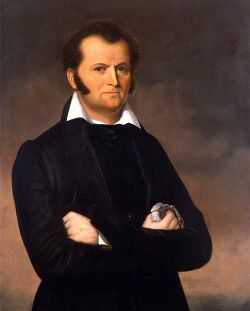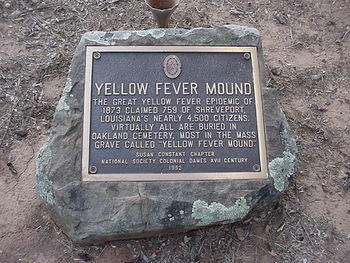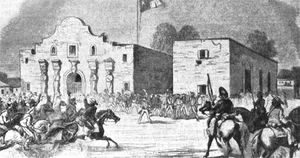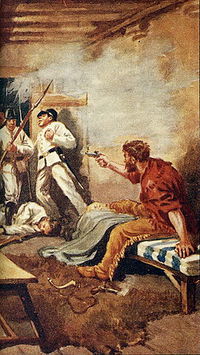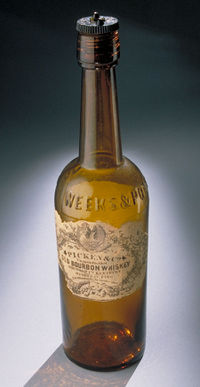The Mysterious Illness of Jim Bowie: How Did He Contribute to His Own Decline
Directly or indirectly, James Bowie’s (aka Jim) enigmatic illness during the siege of the Alamo resulted from his actions. A hearty man of six feet, Bowie was a walking contradiction; a slave trader who fought for freedom, a generous and congenial man who had his thunderous temper, and a commanding leader who was prone to binges of sloppy drunkenness. He was determined in his actions and proceeded through life with an indestructible will, yet found himself bed-ridden as he took his last breath.
Many suppositions have been made as to the cause of his infirm, including typhoid fever, pulmonary consumption, and traumatic injury. Other possibilities will be proposed in this text and will all lead to the conclusion that by indirect association or direct action, Jim Bowie contributed to his demise.
What happened during Jim Bowie's Life?
James Bowie died on the morning of March 6, 1836 at the hands of the Mexican Army during the siege at the Alamo. His journey to San Antonio began in Kentucky, where he was born in 1796, and continued along the Cumberland and Mississippi Rivers until he reached Louisiana with his family in the early 19th century.[1]The Bowie family owned a plantation in southern Louisiana in 1809, one year after the United States Constitution barred the international trade of slaves. Upon the death of his father in 1821, James and his brothers bought and sold slaves illegally through pirated slave ships in the Caribbean. Slaves and the ships that contained them had originated in Africa and were bound for the West Indies.
African men and women possessed a higher immunity to mosquito-borne illnesses than whites due to exposure over time. Trafficking slaves into the United States exposed Anglo-Americans to infected mosquitoes that were transported along with slaves on filthy, wooden ships. Africans living in the West Indies proved resistant to these types of illnesses, especially yellow fever, as in evident in statistics reported from St. James, Jamaica between 1817 and 1820 showing that the largest number of Africans died of “old age”.[2]Dealing directly with pirated slaves and the surrounding unsanitary conditions put Bowie at a higher risk of coming into contact with an infected mosquito; the only way in which one can contract yellow fever. Consequentially, Jim Bowie participated in and enabled the onset of one potential cause of his illness.
Until October 1833, Bowie's life continued unabated, but tragedy struck. While in Natchez he learned the news that his wife had passed away due to cholera. This occurred just days after he himself recovered from a bout with yellow fever.[3] According to the Centers for Disease Control (CDC), once having recovered from yellow fever one is usually protected against subsequent infection. This, however, is under ideal circumstances wherein the individual is in optimal physical condition. Alcohol and malnutrition impede the immunity process.[4] Bowie was not only complicit in transporting infected mosquitoes into North America, he also counteracted his own recovery with his lifestyle choices.
Was Jim Bowie an alcoholic?
By several accounts, Jim Bowie was an alcoholic. Anson Jones, a physician who would later become the fourth and final President of the Republic of Texas, had the experience of meeting Bowie and Sam Houston while the two were in consultation at San Felipe. Jones found Houston to be the rowdy leader while he found Bowie “dead drunk.” [5] The reasons for Bowie’s alcohol abuses have yet to be determined. He undoubtedly suffered from physical pain resulting from him skirmishes and battles that included gunshot wounds. Depression is another possible explanation for his over-indulgences due to the loss of his wife and child to cholera in 1833. Regardless of why he drank, he continued to do so at an accelerated rate.
Neither Colonel William Travis nor confinement at the Alamo complex quelled Bowie’s drinking. Travis, commanding the regular army, was soon pitted against Bowie in a dispute as to which man would lead the forces in Bejar. The volunteer army, untrusting of Travis’ official authority, instinctively followed Bowie’s directives. Trying to placate all those concerned, Travis ordered an election to choose either Travis or Bowie to lead the troops. The result put Bowie in command of the volunteers and Travis maintained control of the formal troops.
In a letter from Travis to Texas governor Henry Smith, he complained that “since his election” Bowie has been “roaring drunk all the time.” [6] Travis was a traditional army officer with formal training while Bowie was becoming increasingly unmanageable. Colonel Travis concluded that his larger-than-life counterpart could not be restrained. Travis resolved to let Bowie continue and was not responsible "for the drunken irregularities of any man.” [7]
Acting irrationally from the time of the informal election until the siege began, Bowie remained in a drunken or confused state. Rowdiness ensued when he began releasing Mexican prisoners and stopping “carts laden with the good of private families”.[8] To harass ordinary citizens was uncharacteristic of Bowie. These actions strongly suggest that Bowie was not only drunk but was acting irrationally and out of character.
Although he remained literate, his decision-making abilities were compromised and Bowie had been described as confused or disoriented, which are symptoms that present in end-stage yellow fever.[9]Conversely, Bowie remained physically active and there are no records of him showing overt signs of physical illness at this time. By most accounts, Bowie arrived inside the Alamo compound without illness. Signs and symptoms; however, may not present until the disease is well advanced.
Was the Alamo well stocked with medicine before the Seige?
Doctor Amos Pollard, who was present at the hospital in Bejar, wrote to Governor Smith that he was “nearly destitute of medicine” and continued to say he could be “of very little use to the sick” were an attack to occur.[10] Lack of medicine combined with the lack of nutritious food and poor sanitary conditions created an ideal environment for disease to thrive. A water-well in the center of the Alamo courtyard did provide fresh water but was also a breeding ground for mosquitoes. It is possible that Bowie contracted yellow fever for a second time if he did not fully recover from his first bout with the disease.
Upon contracting yellow fever in 1833, Bowie had access to medicinal plants and herbs which may have aided in his recuperation and provided a false sense of recovery. While confined at the Alamo compound, he and his peers had access to only sparse amounts of food and what was available held little nutritional value or healing qualities. The combination of his noted binge drinking, the breeding well for mosquitoes and the sources from which they derived the disease ——— slaves ——— the setting was ideal for Bowie to contract yellow fever a second time.[11] The reports are conflicting as to the events surrounding Bowie’s death, but all concur with regards to the symptoms he was presenting.

How did Bowie Die at the Alamo?
Andrea Castanon de Villanueva, more commonly known as Madam Candelaria, gave several different accounts as a witness to the siege at the Alamo. They all conflict as to the manner in which Bowie was killed but concur as to the symptoms of his illness. Descriptions of Bowie's condition by other witnesses concur with Candelaria's account of him having shortness of breath, a continued cough, rapid pulse and fever, and the loss of "considerable flesh."[12] It must be noted; however, that the credibility of Candelaria must be closely scrutinized as she had no medical or nursing background and often contradicted herself in interviews. In an 1890 interview she was convinced he was "very ill of typhoid fever," while in an interview from 1899, she stated that Bowie was "afflicted with consumption."[13]
Generally, there are no respiratory symptoms associated with typhoid fever. [14] Henderson Yoakum, a prominent lawyer, historian, and congressional representative from Texas made a strong argument refuting Candelaria’s claim to having been Bowie’s nurse. In a letter dated January 8, 1870, to an unknown recipient, Yoakum argues that Juana Alsbury nursed Bowie at the Alamo and that Madam Candelaria was not even present at the time of the siege.[15] Yoakum deduced that Mrs. Alsbury would have been the choice to nurse Bowie as she was the niece of former governor Veramendi and Bowie’s sister-in-law. The note claims that Alsbury was not aware of another woman nursing Bowie.
Conflicting evidence is not new to the story of the Alamo as myths and legends have been abundant since March 6, 1836, the day Santa Anna's troops toppled the Alamo and slaughtered its defenders. One that was once believed to be fact, which has since been refuted by historians, is that Bowie fell from a parapet resulting in an injury that caused his physical decline. Medically this was possible if his injury resulted in a pulmonary embolism. Emboli are often the result of a blood clot traveling from the leg to the lungs; however, they can also develop from a fatty deposit dislodging from a broken bone. If Bowie had fallen from such a height, a fracture of one of his ribs, or any bone, was highly probable. Untreated emboli are fatal and the symptoms, which include shortness of breath, chest pain, and a bloody cough, present themselves with sudden onset.[16] All of these elements fit the description of Bowie’s illness, yet there has not been documentation found to substantiate him having fallen. The only documented and undisputed testimony is that Bowie was bed-ridden at the time of the assault on the Alamo.
All of Bowie's so-called nurses agreed that he was bedridden at the time of the siege, yet a soldier with Santa Anna's army denied seeing Bowie or anyone else in bed when the Mexican army stormed the compound. In his diary, With Santa Anna in Texas, Jose Enrique de la Pena vividly describes the scene on the morning of March 6, 1836, as one of bloody confusion and unfathomable carnage. According to de la Pena, Travis did not withdraw when the Mexican troops scaled the walls of the fortress; rather he died fighting. He described the others as "terrified defenders" who " withdrew" and "bolted and reinforced the doors."[17]
Why was Jim Bowie sick during the Seige of the Alamo?
Jim Bowie, due to his excessive drinking and bold actions, essentially harmed himself to the point that death was imminent regardless of the events that transpired that March morning in San Antonio. Alcohol abuse causes many detrimental effects on the human body, not least of which is cardiomyopathy.[18] Another serious complication that has been overlooked by historians is that of alcoholic pneumonia. This is a condition wherein an individual drinks to the point of unconsciousness and regurgitates the contents of the stomach into the lungs.
Once the foreign matter is introduced, the sacs in the lungs inflame due to the excessive amount of white blood cells present trying to rid the body of the invasive substance. Resulting from this physiological phenomenon is the presence of fluid in the lungs known as pneumonia. Untreated, pneumonia can be fatal and produce such symptoms as a bloody cough, debilitating weakness, fever, chills, and shortness of breath.[19] Given Bowie’s alcoholic tendencies and documented history as a binge drinker, this diagnosis is highly plausible if not probable.
Doctor Pollard described the medical facilities in Bejar as having no medication to treat the sick or wounded. The sanitary conditions in Bejar and inside of the Alamo compound itself have been described as deplorable. Bowie continued to drink, which compromised his immune system. Nourishment was limited to bits of corn and the few heads of cattle that were driven into the fortress. The presence of pneumonia with no available medication, a lack of nutrition, and a chronically compromised immune system is fatal and was very likely the cause of James Bowie's death.
Conclusion
If one wishes to remember Bowie as a tragic hero falling from a parapet and contracting tuberculosis, there is a very slight chance that this occurred. In describing consumption in 1799, Dr. Thomas Beddoes stated, “We have seen how often external injury produces the disease”.[20]Advancements in science, however, have given us the educational tools to further Dr. Beddoes' research and question whether he was describing pulmonary consumption or a pulmonary embolism.
Death was inevitable for Bowie, whether at the hands of the Mexican army or his own. The abuses he inflicted on his body would have a shortened life-span, even in today’s technologically advanced society. Frontier medicine of the 19th century was rudimentary and often times unattainable. Had Bowie received care in March of 1836 he would not have recovered to the extent possible due to his alcohol consumption. By participating in the illegal slave-trade of post-1808 North America, he indirectly enabled disease-ridden insects access to the continent.
Slavery was not practiced in Mexico, yet slaves were present at the Alamo compound because of men like Bowie. Stagnant water was on hand due to the well inside the fortress. The preponderance of evidence suggests yellow fever as being the nature of Jim Bowie’s illness but alcoholic pneumonia needs further investigation as Bowie was a prime candidate for such an affliction. Other possibilities exist but due to Santa Anna’s choice to cremate the dead bodies found on the morning of March 6, 1836, no definitive conclusion can be drawn. Death took Jim Bowie in the same manner in which he approached life; fearlessly and without a doubt.
Related DailyHistory.org Articles
References
- Jump up ↑ William C. Davis, Three Roads to the Alamo (New York: Harper, 1998), 35-62.
- Jump up ↑ B.W. Higman, Slave Population and Economy in Jamaica, 1807-1834 (University of the Indies Press, 1995), 112.
- Jump up ↑ Davis, 361-362.
- Jump up ↑ Valerie Carter, RN, BSN, MSN, interview by author, Phoenix, Arizona, April 15, 2010. It has been historically documented that Bowie consumed a great deal of alcohol. Also, malnutrition must be distinguished from under-nutrition in that an individual may be consuming substantial calories that lack nutritional value.
- Jump up ↑ Anson Jones, Memorandum and Official Correspondence Relating to the Republic of Texas, Its History and Annexation (New York: 1859), 12-13.
- Jump up ↑ Travis to Henry Smith, Bejar, February 13, 1836, in Official Correspondence of the Texan Revolution, 1835-1836, ed. William C. Binkley (New York: D. Appleton-Century, 1936), 1:419-420. Travis continues in the letter with descriptions of Bowie acting in a disorderly fashion, destroying property, and releasing incarcerated prisoners.
- Jump up ↑ Travis to Smith, 420.
- Jump up ↑ J.J. Baugh to Henry Smith, Bejar, February 13, 1836, in Official Correspondence of the Texan Revolution 1835-1836, ed. William C. Binkley (New York: D. Appleton-Century, 1936), 1:421-422. J.J. Baugh was Adjunct to the Post of Bejar.
- Jump up ↑ CDC, Yellow Fever.
- Jump up ↑ Amos Pollard to Henry Smith, Bejar, February 13, 1836, in Official Correspondence of the Texan Revolution, 1835-1836, ed. William C. Binkley (New York: D. Appleton-Century, 1936), 1:423.
- Jump up ↑ CDC, Yellow Fever Transmission. Africans had acquired immunity to yellow fever, thus making them carriers of the disease. Travis’ slave, “Joe” was present inside the Alamo and was likely a carrier. The process of transmission is as follows; a mosquito bites a carrier and contracts the virus then transmits the disease to someone without immunity through biting.
- Jump up ↑ Maurice Elfer, Madam Candelaria: Unsung Heroine of the Alamo (Houston: Rein, 1933),9.
- Jump up ↑ Bill Groneman, Eyewitness to the Alamo, (Plano: Taylor Trade Publishing, 1996), 107.
- Jump up ↑ Groneman, 122. Pulmonary consumption was a term used in the 19th century for what is currently known as tuberculosis.
- Jump up ↑ Henderson Yoakum, “The McArdle Notebooks,” (Austin, Texas State Library), 29.
- Jump up ↑ Carter, Interview.
- Jump up ↑ Jose Enrique de la Pena, With Santa Anna in Mexico, Carmen Perry, ed. and trans. (College Station: Texas A&M Press, 1975), 50-51.
- Jump up ↑ An enlargement of the heart causing it to no longer function properly.
- Jump up ↑ Carter, Interview.
- Jump up ↑ Thomas Beddoes, Essay on the causes, early signs, and prevention of pulmonary consumption… (Bristol, 1799), 62.
Admin, Costello65 and EricLambrecht
Updated January 22, 2019
